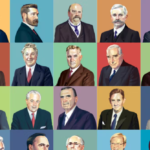Developing a design mindset rather than just methods and tools
Design thinking is a growing trend in business. Melis Senova explains what it is and how Huddle Academy supports people adopt a different mindset so they can lead the charge for large organisations.
In a time where businesses are beginning to focus on customer centricity and meaningful value exchange, they are also looking to people with different characteristics within their organisations. These characteristics are not the usual ones we hear about in traditional big business. They include empathy, imagination, belief in possibility, vulnerability, and humility.
Another shift is that businesses require skills that can bring something into existence, the genesis of new ideas and the meaningful implementation of them. The fierce competition for brand recognition is directly linked to how well and meaningfully a business can innovate their value propositions so they remain relevant to the people who choose to buy or participate in them. This points to the need for different ways of working.
This is one reason there is a growing interest in the role of design in business. This is not design in the sense we traditionally understand it. I am not referring to visual design. When I use the term design I am referring to a very broad definition of the term, which can be encapsulated by the deliberate creation of meaningful outcomes that address complex challenges. The trick here is in the mindset and ways working that design brings.
Huddle Academy has been established to fill a gap in the design education space. Currently, as design thinking is a growing trend, there are many courses that run for varying durations that provide great foundational training in the methods and tools of design. Thanks to the work completed by Dr Harold Nelson who thought about the different competency sets of design, we adopted the four ‘sets’ model of capability building. When we think about design capability at Huddle, we think about it in terms of mindset, knowledge set, skill set and tool set. Many of the current industry training programs address the important sets of skills and tools. At Huddle Academy we address the top two, mindset and knowledge set. Of course, these two sets are more difficult to ‘train’ so Huddle Academy has a different approach to education.
Huddle Academy teaches aspects of human centred design most relevant to solving ecosystemic problems. It primarily focusses on fostering a mindset that enables great outcomes for people using design as a way of thinking and doing. We chose to focus on this aspect of building design capability within people as it fundamentally shapes how the skill sets and toolsets are applied to situations.
Customer led by design, our flagship program, enables leaders to embrace and lead human centricity in their teams and organisation. It focuses on developing mindsets across topics of human centred design fundamentals, understanding and applying empathy, developing leadership in the service of others, and navigating and harnessing complex problems and contexts. It does this through combining a unique blend of immersive learning experiences, small group collaboration and individual self-directed activities across a nine week program.
To design meaningful solutions for people we need to first have the ability and the will to understand them in terms that can be designed for. To really get to the insights that sit behind the observable behaviours and experiences. Huddle Academy crafts learning experiences that enable these mindsets and capabilities to be developed that can then be applied to your current work context.
Dr. Melis Senova is a pioneer in design thinking and founder of global strategic design consultancy, Huddle. She is a leader committed to making a positive change to humanity and focussed on human-centred design for the transformation of service, culture, communities and business. Melis has deep academic qualifications and vast business experience, underpinned by a PhD in Human Factors (user-centred design).
A highly regarded and enterprising thought-leader, Melis brings innovation and creativity to lead businesses and organisations towards exciting and ground-breaking frontiers through the power of design. By collaborating with other influential change makers on a global scale, Melis seeks to provide pathways to re-imagined realties.
Melis is also the founder of Huddle Labs (a research capability innovating the definition of value in a post-capitalist society), Huddle Academy (a school focussed on building creative problem solving skills for individuals and organisations) and Huddle Foundation (a platform that connects designers, philanthropists and social enterprises). She is a member of Creative Victoria’s Creative State Advisory Board, a member of the Victorian State Government’s Innovation Expert Panel, and a member of the advisory board for A Vision for Australia (a series of Annual Economic Summits hosted by Global Access Partners).












